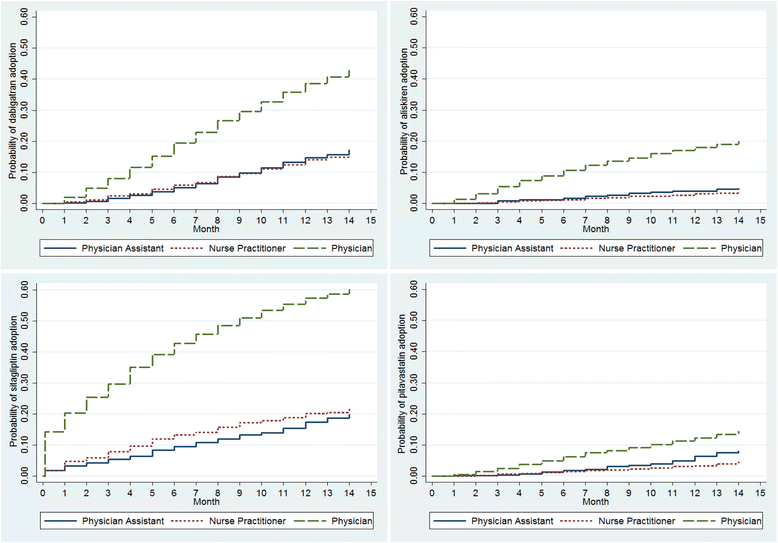New chronic disease medication prescribing by nurse practitioners, physician assistants, and primary care physicians: a cohort study
- PMID: 27464570
- PMCID: PMC4964005
- DOI: 10.1186/s12913-016-1569-1
New chronic disease medication prescribing by nurse practitioners, physician assistants, and primary care physicians: a cohort study
Abstract
Background: Medications to treat and prevent chronic disease have substantially reduced morbidity and mortality; however, their diffusion has been uneven. Little is known about prescribing of chronic disease medications by nurse practitioners (NPs) and physician assistants (PAs), despite their increasingly important role as primary care providers. Thus, we sought to conduct an exploratory analysis to examine prescribing of new chronic disease medications by NPs and PAs compared to primary care physicians (PCPs).
Methods: We obtained prescribing data from IMS Health's Xponent™ on all NPs, PAs, and PCPs in Pennsylvania regularly prescribing anticoagulants, antihypertensives, oral hypoglycemics, and/or HMG-Co-A reductase inhibitors pre- and post-introduction of five new drugs in these classes that varied in novelty (i.e., dabigatran, aliskiren, sitagliptin or saxagliptin, and pitavastatin). We constructed three measures of prescriber adoption during the 15-month post-FDA approval period: 1) any prescription of the medication, 2) proportion of prescriptions in the class for the medication, and 3) time to adoption (first prescription) of the medication.
Results: From 2007 to 2011, the proportion of antihypertensive prescriptions prescribed by NPs and PAs approximately doubled from 2.0 to 4.2 % and 2.2 to 4.9 %, respectively. Similar trends were found for anticoagulants, oral hypoglycemics, and HMG-Co-A reductase inhibitors. By 2011, more PCPs had prescribed each of the newly approved medications than NPs and PAs (e.g., 44.3 % vs. 18.5 % vs. 20 % for dabigatran among PCPs, NPs, and PAs). Across all medication classes, the newly approved drugs accounted for a larger share of prescriptions in the class for PCPs followed by PAs, followed by NPs (e.g., dabigatran: 4.9 % vs. 3.2 % vs. 2.8 %, respectively). Mean time-to-adoption for the newly approved medications was shorter for PCPs compared to NPs and PAs (e.g., dabigatran, 7.3 vs. 8.2 vs. 8.5 months; P all medications <0.001).
Conclusions: PCPs were more likely to prescribe each of the newly approved medications per each measure of drug adoption, regardless of drug novelty. Differences in the rate and speed of drug adoption between PCPs, NPs, and PAs may have important implications for care and overall costs at the population level as NPs and PAs continue taking on a larger role in prescribing.
Keywords: Health services research; Pharmacoepidemiology; Primary care; Work force.
Figures


Similar articles
-
Patterns and predictors of physician adoption of new cardiovascular drugs.Healthc (Amst). 2018 Mar;6(1):33-40. doi: 10.1016/j.hjdsi.2017.09.004. Epub 2017 Oct 21. Healthc (Amst). 2018. PMID: 29066168 Free PMC article.
-
Physician assistant and nurse practitioner prescribing: 1997-2002.J Rural Health. 2005 Fall;21(4):355-60. doi: 10.1111/j.1748-0361.2005.tb00107.x. J Rural Health. 2005. PMID: 16294660
-
Prescribing trends by nurse practitioners and physician assistants in the United States.J Am Acad Nurse Pract. 2006 Jun;18(6):291-6. doi: 10.1111/j.1745-7599.2006.00133.x. J Am Acad Nurse Pract. 2006. PMID: 16719848
-
Understanding the role of advanced practice providers in oncology in the United States.JAAPA. 2018 Dec;31(12):1-12. doi: 10.1097/01.JAA.0000549592.10756.4a. JAAPA. 2018. PMID: 30489397 Review.
-
Impact of issuing longer- versus shorter-duration prescriptions: a systematic review.Br J Gen Pract. 2018 Apr;68(669):e286-e292. doi: 10.3399/bjgp18X695501. Epub 2018 Mar 12. Br J Gen Pract. 2018. PMID: 29530921 Free PMC article.
Cited by
-
Impact of physician assistants on quality of care: rapid review.BMJ. 2025 Jul 3;390:e086358. doi: 10.1136/bmj-2025-086358. BMJ. 2025. PMID: 40610033 Free PMC article.
-
Avoiding Medicaid: Characteristics Of Primary Care Practices With No Medicaid Revenue.Health Aff (Millwood). 2021 Jan;40(1):98-104. doi: 10.1377/hlthaff.2020.00100. Health Aff (Millwood). 2021. PMID: 33400572 Free PMC article.
-
Diabetes medication prescribing trends based on provider type and location in the United States.Prev Med Rep. 2024 Dec 12;49:102947. doi: 10.1016/j.pmedr.2024.102947. eCollection 2025 Jan. Prev Med Rep. 2024. PMID: 39802219 Free PMC article.
-
Complexity as a factor for task allocation among general practitioners and nurse practitioners: a narrative review.BMC Fam Pract. 2020 Feb 17;21(1):38. doi: 10.1186/s12875-020-1089-2. BMC Fam Pract. 2020. PMID: 32066391 Free PMC article. Review.
-
FQHC Designation and Safety Net Patient Revenue Associated with Primary Care Practice Capabilities for Access and Quality.J Gen Intern Med. 2021 Oct;36(10):2922-2928. doi: 10.1007/s11606-021-06746-0. Epub 2021 Aug 3. J Gen Intern Med. 2021. PMID: 34346005 Free PMC article.
References
MeSH terms
Grants and funding
LinkOut - more resources
Full Text Sources
Other Literature Sources
Medical

